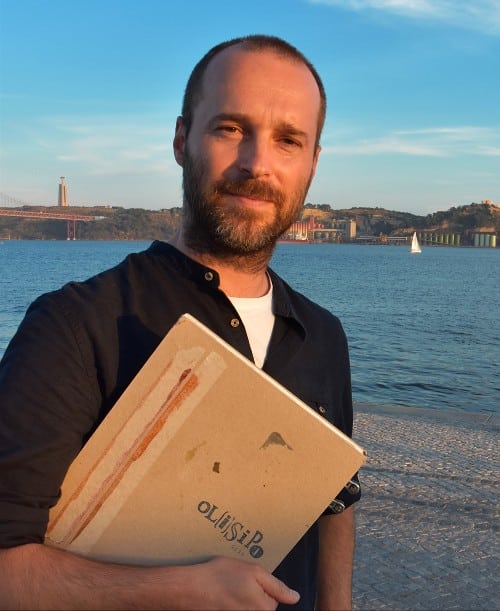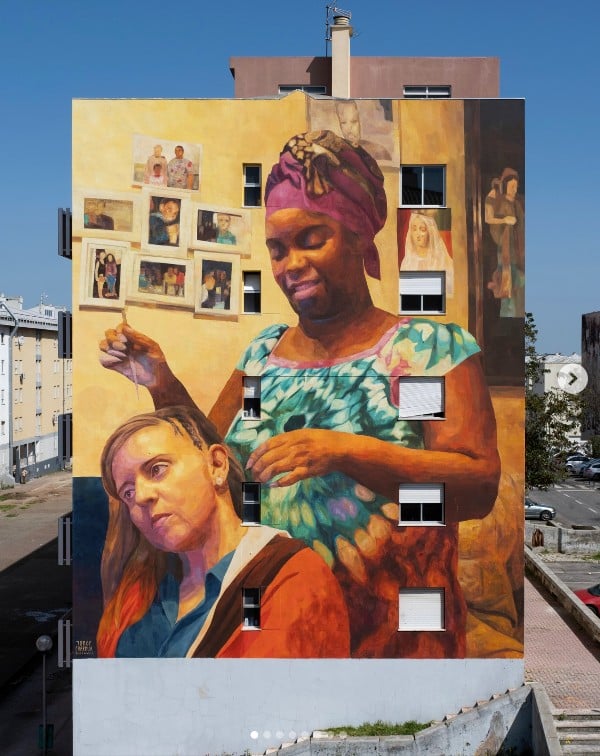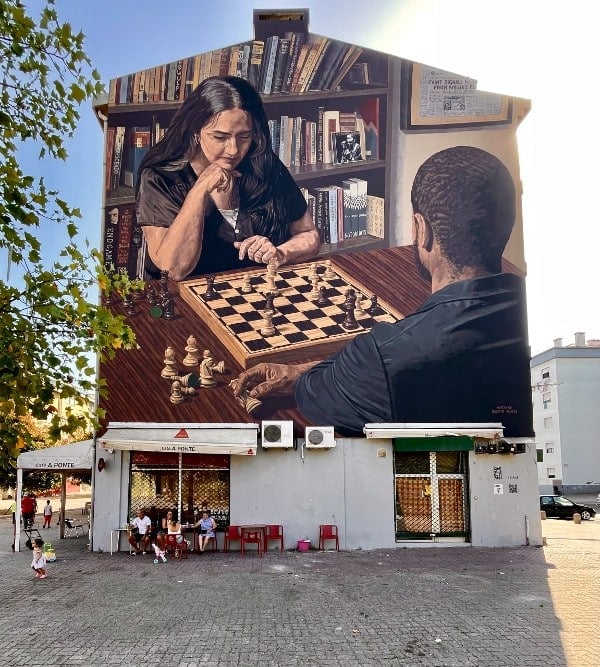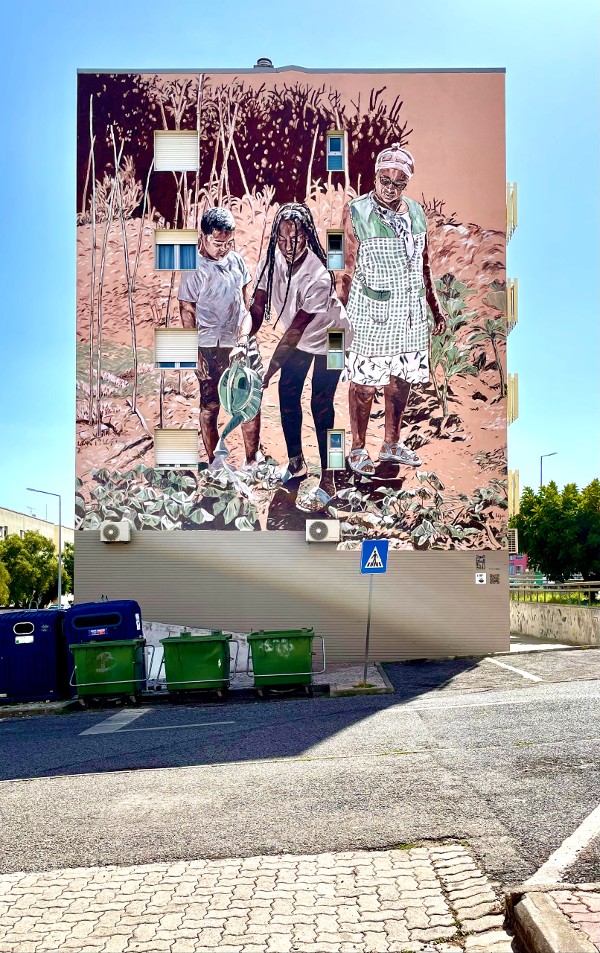It is an innovative and bold project that aims to make Bairro do Zambujal, located in the municipality of Amadora, Lisbon, the first social neighbourhood in the world to be an ambassador for the United Nations’ Sustainable Development Goals (SDGs).
Thanks to the work and dedication of the NGO Ad Gentes and the CAZAmbujal association, over the last few months, this social housing neighbourhood with around 4,000 inhabitants has seen the creation of an urban art gallery on the 17 SDGs that aims to act as an agent of social change and promote sustainability.
17 artists with different inspirations and techniques have been working to complete the urban art gallery by the end of the year. The new SDG route will aim to attract visitors, tourists, and students to the neighbourhood.
The Zambujal 360 project is not just about art; it’s about transforming lives. It’s about training young people, establishing a network of traders, requalifying urban spaces, and promoting a vibrant artistic, social, and cultural life in the community.
This project, endorsed by the United Nations Regional Information Center for Western Europe (UNRIC) and financed by 17 Portuguese entities, including foundations, municipalities, and private sector companies, can now be visited.
UNRIC’s Portuguese desk was in the neighbourhood and spoke to Mário Linhares, one of the Zambujal 360 promoters.
UNRIC: How did the idea for Zambujal 360 come about?
Mário Linhares: This project was born from many years of volunteering and listening to the local community’s concerns. There was the idea of painting a staircase, of promoting neighbourhood commerce and the positive things that exist here. The community was unaware of the Sustainable Development Goals (SDGs), and we saw them as the unifying theme to enhance much of what people already do and/or dream of doing. Suddenly, they realized that local projects, in fact, relate to global issues.
In short, we started by listening and diversifying what people were already doing and wanted to do. Then, we needed to guarantee the funding, naturally. Once it was secured, we could move forward with the project.

UNRIC: What did the whole process look like?
Mário Linhares: Securing financing was a complex process. We had previously applied for financial support with other projects. It is pretty difficult to get selected, making everything frustrating. With Zambujal 360, we were convinced that the project had to happen regardless of anyone telling us that it wouldn’t, so competing for funds was part of the equation.
We started by consolidating the concept and quantifying expenses. We divided the budget into 17 parts and looked for 17 entities that were the perfect match for each SDG and would thus guarantee the necessary funding. We knocked on many doors, and many didn’t open, but little by little, we began to receive positive responses that motivated us and helped more partners believe in our work. It was a long road of meetings and presentations. Still, the responses we received also helped us improve our communication and content until we got all the funding.

UNRIC: Ten murals have already been completed. In most cases, the community is involved in the artistic work. Can you give some examples of how this was done?
Mário Linhares: In SDG 1 – Eradicate Poverty, for example, we wanted to start with real stories of people who turned things around concerning poverty. The painting we have tells the story of two unlikely sisters who grew up together. This is because a family in the neighbourhood adopted one of them. One is white, and the other – is Cape Verdean[AV1]; it is a compelling story, as it also shows how racism makes no sense. Because she belonged to an extended family, she had access to experiences and opportunities she would not have had with her biological family alone. It’s a very inspiring story!
In fact, the neighbourhood is full of stories of families and people who turned things around, which is incredible to see. Sometimes, you must be in contexts like these to realize that overcoming is always possible, even in difficult situations. When we can’t do it alone, the community we are part of can and should help.
But this project is more than just artistic. It intends to be the starting point for initiatives that have a social impact on the neighbourhood.

Check the making-off of the mural on the SDG 5 – Gender Equality.
UNRIC: Can you explain how it will be done?
Mário Linhares: When someone hears about Zambujal 360, they might think it’s just another urban art project, but when they visit us, they quickly realize that our urban art gallery on the SDGs means much more. For example, on SDG 5 – Gender Equality, is represented by a game of chess. In this intellectual game, men and women compete equally, regardless of their physical strength.
We want to call chess associations to the neighbourhood and encourage children to play chess. Moreover, this wall portrays many books by different authors that directly or indirectly address the topic of gender equality. This way, we also want to promote reading and dialogue so that people become restless and want to read some of these authors.
The main idea is that each painting and its respective SDG are a match that initiates and leads to transformation. It may be more personal, internal, or within the community, but we are creating conditions for something different.
In addition, some partners want to contribute beyond what we imagined. For example, the EDP (Portuguese Electricity Company) intends to install renewable energy panels to make buildings more energy efficient, bringing its know-how related to SDG 7. The Portuguese Mint Office wants to publish a book with all the stories of the paintings. The Luso-American Development Foundation (FLAD) promotes the project to North American university students studying in Portugal. The Altice Foundation also supports us with technology and communications. Vieira de Almeida gives us legal support. These are just a few examples of how partnerships can always be more than just the initial sketch.

UNRIC: When are all the murals expected to be completed? The idea is to have an SDG route that attracts tourists and visitors and brings more people to the neighbourhood…
Mário Linhares: I’ve decided to ask Chat-GPT where one should go to learn more about the SDGs. The first answer it gives is to go to the United Nations headquarters in New York. There are no other specialized places on the topic.
In Portugal, the Zambujal neighbourhood is already a place to visit to learn more about the 17 SDGs. Teachers and students of any academic cycle or degree are welcome, as are companies, associations, family members, and tourists. To visit us, you need to buy a ticket for a guided tour, which allows you to learn about the history of the neighbourhood, the paintings, and their relationship with the SDGs.
The training we are providing to young people will allow them to become SDG ambassadors. As it is a paid guided tour, each young person will be paid for their work. This is our sustainability model; in addition to guaranteeing the project’s economic autonomy, it enables decent work for young people.
But not to avoid the question, we hope to have the SDG urban art gallery ready by the end of 2024. One of the murals will be ceramic! This way, we will honour Portugal’s long historical tradition in urban art through clay modelling and tiles.
In Portugal, a place not on the map before will become a source of interest and debate: the Zambujal neighbourhood, the first social neighbourhood ambassador of the 17 SDGs.
Find out more about Zambujal 360.
